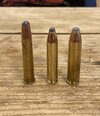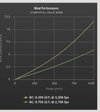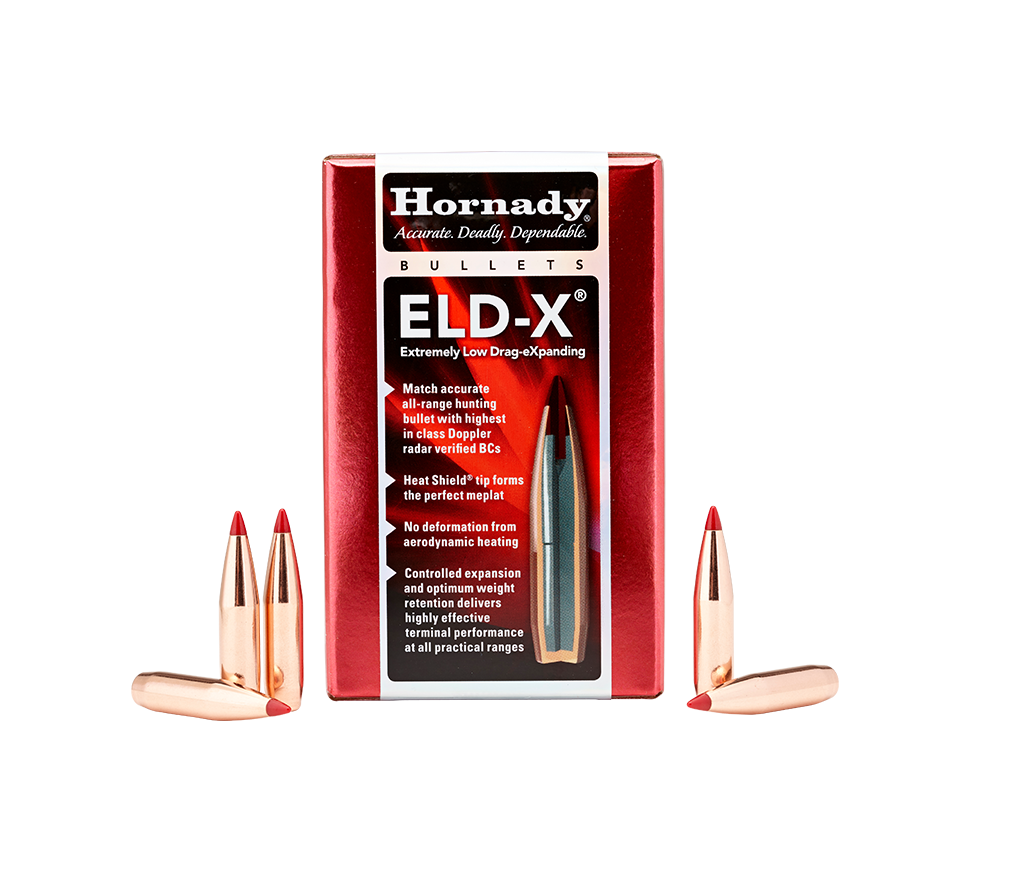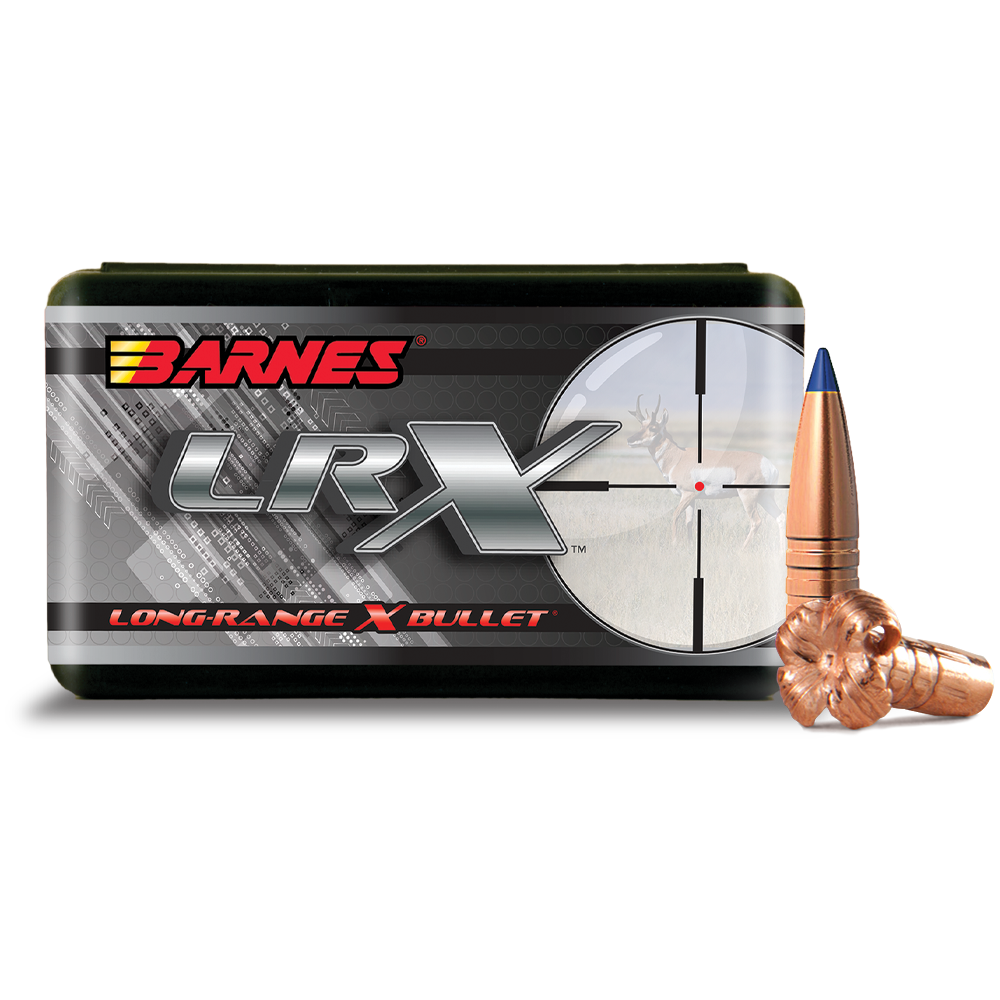westernrover
Member
- Joined
- May 4, 2018
- Messages
- 1,613
I have rifles chambered in a few different cartridges like 6.5 Grendel, 6.5 Creedmoor, and 6.5 PRC. All these are capable of shooting relatively lightweight bullets of ~100 grains as well as long, low-drag bullets. Their set-back shoulders distinguish them from older cartridge designs that favored greater case capacity, and even older designs that would have been more tapered. The proposition of these 21st century cartridge designs is that they fit the long, low-drag bullets and fire them efficiently. Because we are supposed to have laser rangefinders, the drop from initially lower velocities due to heavier bullets and smaller case capacities from set-back shoulders is claimed to be worth the tradeoff because of the prospect of preserving velocity out to longer ranges.
Light, Midweight, or Low Drag
Let me take 6.5 Creedmoor for a single example. For all my calculations, I am using Barnes' published load data. I can load 100 grain TTSX (.359 G1 BC) to a muzzle velocity of about 3200 fps. I can load 127 grain LRX (.468 G1 BC) to about 2900 fps. I can load a 145 grain Match Burner (.703 G1 BC) to 2700 fps. The 100 grain TTSX is proven as an excellent hunting bullet for Mule Deer. It's not too light. Yet because it is light, the modest Creedmoor cartridge will deliver high velocity and flat trajectory. In fact, it is faster and flatter than the others out to 1000 yards where it will have dropped as much as the Match Burner. It won't drop as far as the LRX until 1500 yards.
Velocity, Trajectory, Energy
For hunting bullets like the TTSX or LRX, the latter's advantage in lower drag doesn't result in a flatter trajectory. Does it have more energy? Whether energy is a meaningful measurement or not is another debate, but in this case, I think it represents the heavier, lower-drag bullet's ability to maintain effectiveness over time and distance. At the muzzle, the 100 grain bullet starts off with a slight advantage in energy due to the formula for energy greatly favoring velocity. At 100 yards, they even up. By 200 yards, the slight advantage has gone to the 127 grain bullet. Even though the 100 grain TTSX still has a significant velocity advantage of 270 fps at 200 yards, it has lost more of its energy to drag at this point and has fallen below the energy level of the LRX. Even so, those first 200 yards covers most hunting situations. By 500 yards, the TTSX is still higher than the LRX, having dropped only 34.5" vs. 42.3". It still has more velocity and 88% as much energy. After 500 or 600 yards, both are dropping below 1000 ft. lbs. of energy, but neither will go transonic until well after 1000 yards.
The advantage of the low-drag hunting bullet doesn't seem very remarkable. What's more is that that same bullet could be used in a traditional cartridge like 260 Remington. In fact, I would argue that an 80 to 95 grain bullet in 243 Winchester would be faster, flatter, and do everything needed at least as well or better than the new-fangled extreme low-drag optimized cartridge.
The reason for this is because a .468 G1 BC is not that sleek. It's not the kind of bullet that is unique to the Creedmoor or PRC cartridges. For that, we need a bullet with a .700+ G1 BC. Looking at a 145 grain Match Burner in 6.5 Creedmoor, at 500 yards, it has 50% more energy than the hunting bullets. It doesn't drop below 1000 ft. lbs. of energy until nearly 1000 yards or almost twice as far as the hunting bullets. But it isn't a hunting bullet and can't be expected to have the terminal effect of a hunting bullet. The energy on a paper target doesn't really matter or it doesn't matter to me.
Overbore Belted Magnums
If we go back to the Belted Magnum era, flat trajectories were the thing. Nobody had laser rangefinders, most scopes weren't setup to dial, and hunters shot MPBR. We had big overbore cartridges that shot lightweight bullets on laser-like trajectories. The 257 Weatherby exemplifies this trend, but so did the 300 Win Mag., and pretty much all the small-bore Weatherbys and Win Mags -- and it was a trend like I think the current low-drag Creedmoor/PRC thing is.
Shooting the 100 grain TTSX out of a belted magnum case will produce 3600 fps at the muzzle. For the mid-weight bullets, it's about the same as the PRC but it cannot shoot the really long heavyweight bullets like PRC. While the PRC could shoot the lightweight bullet, the magnum has been doing it for 60 more years. Did they get it right all those years ago? Well, it shoots flatter than anything, even the 700 G1 BC Match Burner, out to a mile. More importantly, consider the MPBR for a 6" target with a 200 yard zero:
TTSX Creedmoor 290 yards
LRX Creedmoor 305 yards
MB Creedmoor 285 yards
TTSX Magnum 325 yards
Ok, so maybe it gets 25 more yards MPBR. That's probably more useful than 100 ft. lbs. of energy, but it's not a game-changer. The fact is any of these cartridges would suffice for shooting deer, antelope, or big-horn MPBR out to 275 yards which is quite good indeed. Since the Magnum has been doing it for a half-century longer, I've got to tip it the hat. We shouldn't lose sight of the fact that Creedmoor/PRC do something the older cartridges don't -- they shoot those super low-drag bullets. That just doesn't do anything for me since all I do is hunt.
Old School Tapered Cases
Now of course some people will say we should go all the way back to the Mauser, but that's un-American, so I'll take it back to the 270 because like I wrote, I think the belted-magnum thing was a trend started by Weatherby and then Winchester (I know it originated with H&H but they originally had a practical purpose for the belt, and they did not instigate the hyper-velocity small bore craze). The 270 will shoot the 110 grain TTSX (.377 G1 BC) at 3400 fps. It shoots it with an 6" MPBR of 315 yards. It's flatter than the Match Burner out to 1400 yards. It maintains 1000 ft. lbs. of energy out to 675 yards (the same as the Magnum). I guess the Magnum's advantage is there on paper, it might be a bit more with a 26" barrel vs. the 270's 24" (which are typical lengths respectively, but the data was for 24" on both). Still, I can't imagine it making enough difference to make a difference.
Short Action
I suppose there was a difference when short-actions were a thing, but nowadays, a factory producing short-actions would cut themselves off all the sales of PRC and the one or two belted magnums that remain popular (300 and 7mm). Do popular rifles like the new Ruger American Gen 2 even come in a short action or are they all the same? I know Tikka are all the same. I think if you want a shorter rifle, the trend now is just to lop off the barrel to 16 or 20". Aren't different size actions mostly a "factory-custom" thing at this point?
Mini Action
I mentioned the Grendel in my opening. I've hunted with it and it's fantastic. It's been around longer than the Creedmoor, and for hunting, it does everything the Creedmoor does with either a slightly lighter bullet or just a bit less velocity. It's still got an MPBR out to 285 yards and holds 1000 ft. lbs. of energy out to 340 yards. If it gives up anything, the concession happens at a distance well beyond my hunting ranges. I think this is why we see the 6mm ARC and the 22 ARC also popular -- they play on the strengths of the Grendel, not to mention all the other PPC cartridges that preceded them. I love the CZ 527 that shoots the Grendel, except that it doesn't fit me well. The action is so short it forces the scope too far back. Maybe cantilever rings would fix it because the extreme short action is like a Ruger No. 1. Either of those would be better with irons, but I only hunt with optics.
Here's link to tables and trajectory graphs I used in my examination: http://www.shooterscalculator.com/ballistic-trajectory-chart.php?t=8201c3dc
Conclusion
My conclusion is that the low-drag trend does not offer anything for me in a hunting rifle or cartridge. I can see how it makes an incredible difference in the ballistics when the G1 BC is over .700 and beyond, but I don't hunt with those kind of bullets. So if the low-drag trend isn't for me, is there anything new that does? I suppose the incredibly inexpensive but accurate rifles are a good thing. They allow me to spend more money on the optic. I think there is something to the minimalist trend. Maybe it started with the desire to chamber AR-15's with effective hunting cartridges, but now we have 6.5 Grendel, 6 ARC, 22 ARC. The thing is, we might just be getting closer to proving that with the right bullet, .223 is just fine for hunting. I just started reloading 223 this year (for a non-hunting rifle), but as I've learned more about it, I would totally hunt with it (with a bunch of caveats). The thing is, all it offers me are the mini-actions that don't fit me, and the AR-15 that doesn't appeal to me for hunting. I suppose the other trend I should mention is the minimalist big-bores: the 450 Bushmaster, 350 Legend, and all the other Legends that are coming. I say "minimalist" because they're sized down to fit into an AR-15 magazine and action as opposed to the ample big bore cartridges of the past from the black powder 45-90, to the cordite fueled 470 Nitro, to the double-based belted magnum 458 replicant thereof (whether Win or Lott), the Rigbies and Jeffreys and Weatherbys or even the Rugers. I get the attraction to the short straight-wall cartridges where others are prohibited, but that doesn't apply to me. Because I can realistically expect shots to 300 yards and most will be over 200, I don't see the Legends doing anything for me.
What do you make of the current trends, or the trends of the past? Can one of the new cartridges do anything for your hunting?
Light, Midweight, or Low Drag
Let me take 6.5 Creedmoor for a single example. For all my calculations, I am using Barnes' published load data. I can load 100 grain TTSX (.359 G1 BC) to a muzzle velocity of about 3200 fps. I can load 127 grain LRX (.468 G1 BC) to about 2900 fps. I can load a 145 grain Match Burner (.703 G1 BC) to 2700 fps. The 100 grain TTSX is proven as an excellent hunting bullet for Mule Deer. It's not too light. Yet because it is light, the modest Creedmoor cartridge will deliver high velocity and flat trajectory. In fact, it is faster and flatter than the others out to 1000 yards where it will have dropped as much as the Match Burner. It won't drop as far as the LRX until 1500 yards.
Velocity, Trajectory, Energy
For hunting bullets like the TTSX or LRX, the latter's advantage in lower drag doesn't result in a flatter trajectory. Does it have more energy? Whether energy is a meaningful measurement or not is another debate, but in this case, I think it represents the heavier, lower-drag bullet's ability to maintain effectiveness over time and distance. At the muzzle, the 100 grain bullet starts off with a slight advantage in energy due to the formula for energy greatly favoring velocity. At 100 yards, they even up. By 200 yards, the slight advantage has gone to the 127 grain bullet. Even though the 100 grain TTSX still has a significant velocity advantage of 270 fps at 200 yards, it has lost more of its energy to drag at this point and has fallen below the energy level of the LRX. Even so, those first 200 yards covers most hunting situations. By 500 yards, the TTSX is still higher than the LRX, having dropped only 34.5" vs. 42.3". It still has more velocity and 88% as much energy. After 500 or 600 yards, both are dropping below 1000 ft. lbs. of energy, but neither will go transonic until well after 1000 yards.
The advantage of the low-drag hunting bullet doesn't seem very remarkable. What's more is that that same bullet could be used in a traditional cartridge like 260 Remington. In fact, I would argue that an 80 to 95 grain bullet in 243 Winchester would be faster, flatter, and do everything needed at least as well or better than the new-fangled extreme low-drag optimized cartridge.
The reason for this is because a .468 G1 BC is not that sleek. It's not the kind of bullet that is unique to the Creedmoor or PRC cartridges. For that, we need a bullet with a .700+ G1 BC. Looking at a 145 grain Match Burner in 6.5 Creedmoor, at 500 yards, it has 50% more energy than the hunting bullets. It doesn't drop below 1000 ft. lbs. of energy until nearly 1000 yards or almost twice as far as the hunting bullets. But it isn't a hunting bullet and can't be expected to have the terminal effect of a hunting bullet. The energy on a paper target doesn't really matter or it doesn't matter to me.
Overbore Belted Magnums
If we go back to the Belted Magnum era, flat trajectories were the thing. Nobody had laser rangefinders, most scopes weren't setup to dial, and hunters shot MPBR. We had big overbore cartridges that shot lightweight bullets on laser-like trajectories. The 257 Weatherby exemplifies this trend, but so did the 300 Win Mag., and pretty much all the small-bore Weatherbys and Win Mags -- and it was a trend like I think the current low-drag Creedmoor/PRC thing is.
Shooting the 100 grain TTSX out of a belted magnum case will produce 3600 fps at the muzzle. For the mid-weight bullets, it's about the same as the PRC but it cannot shoot the really long heavyweight bullets like PRC. While the PRC could shoot the lightweight bullet, the magnum has been doing it for 60 more years. Did they get it right all those years ago? Well, it shoots flatter than anything, even the 700 G1 BC Match Burner, out to a mile. More importantly, consider the MPBR for a 6" target with a 200 yard zero:
TTSX Creedmoor 290 yards
LRX Creedmoor 305 yards
MB Creedmoor 285 yards
TTSX Magnum 325 yards
Ok, so maybe it gets 25 more yards MPBR. That's probably more useful than 100 ft. lbs. of energy, but it's not a game-changer. The fact is any of these cartridges would suffice for shooting deer, antelope, or big-horn MPBR out to 275 yards which is quite good indeed. Since the Magnum has been doing it for a half-century longer, I've got to tip it the hat. We shouldn't lose sight of the fact that Creedmoor/PRC do something the older cartridges don't -- they shoot those super low-drag bullets. That just doesn't do anything for me since all I do is hunt.
Old School Tapered Cases
Now of course some people will say we should go all the way back to the Mauser, but that's un-American, so I'll take it back to the 270 because like I wrote, I think the belted-magnum thing was a trend started by Weatherby and then Winchester (I know it originated with H&H but they originally had a practical purpose for the belt, and they did not instigate the hyper-velocity small bore craze). The 270 will shoot the 110 grain TTSX (.377 G1 BC) at 3400 fps. It shoots it with an 6" MPBR of 315 yards. It's flatter than the Match Burner out to 1400 yards. It maintains 1000 ft. lbs. of energy out to 675 yards (the same as the Magnum). I guess the Magnum's advantage is there on paper, it might be a bit more with a 26" barrel vs. the 270's 24" (which are typical lengths respectively, but the data was for 24" on both). Still, I can't imagine it making enough difference to make a difference.
Short Action
I suppose there was a difference when short-actions were a thing, but nowadays, a factory producing short-actions would cut themselves off all the sales of PRC and the one or two belted magnums that remain popular (300 and 7mm). Do popular rifles like the new Ruger American Gen 2 even come in a short action or are they all the same? I know Tikka are all the same. I think if you want a shorter rifle, the trend now is just to lop off the barrel to 16 or 20". Aren't different size actions mostly a "factory-custom" thing at this point?
Mini Action
I mentioned the Grendel in my opening. I've hunted with it and it's fantastic. It's been around longer than the Creedmoor, and for hunting, it does everything the Creedmoor does with either a slightly lighter bullet or just a bit less velocity. It's still got an MPBR out to 285 yards and holds 1000 ft. lbs. of energy out to 340 yards. If it gives up anything, the concession happens at a distance well beyond my hunting ranges. I think this is why we see the 6mm ARC and the 22 ARC also popular -- they play on the strengths of the Grendel, not to mention all the other PPC cartridges that preceded them. I love the CZ 527 that shoots the Grendel, except that it doesn't fit me well. The action is so short it forces the scope too far back. Maybe cantilever rings would fix it because the extreme short action is like a Ruger No. 1. Either of those would be better with irons, but I only hunt with optics.
Here's link to tables and trajectory graphs I used in my examination: http://www.shooterscalculator.com/ballistic-trajectory-chart.php?t=8201c3dc
Conclusion
My conclusion is that the low-drag trend does not offer anything for me in a hunting rifle or cartridge. I can see how it makes an incredible difference in the ballistics when the G1 BC is over .700 and beyond, but I don't hunt with those kind of bullets. So if the low-drag trend isn't for me, is there anything new that does? I suppose the incredibly inexpensive but accurate rifles are a good thing. They allow me to spend more money on the optic. I think there is something to the minimalist trend. Maybe it started with the desire to chamber AR-15's with effective hunting cartridges, but now we have 6.5 Grendel, 6 ARC, 22 ARC. The thing is, we might just be getting closer to proving that with the right bullet, .223 is just fine for hunting. I just started reloading 223 this year (for a non-hunting rifle), but as I've learned more about it, I would totally hunt with it (with a bunch of caveats). The thing is, all it offers me are the mini-actions that don't fit me, and the AR-15 that doesn't appeal to me for hunting. I suppose the other trend I should mention is the minimalist big-bores: the 450 Bushmaster, 350 Legend, and all the other Legends that are coming. I say "minimalist" because they're sized down to fit into an AR-15 magazine and action as opposed to the ample big bore cartridges of the past from the black powder 45-90, to the cordite fueled 470 Nitro, to the double-based belted magnum 458 replicant thereof (whether Win or Lott), the Rigbies and Jeffreys and Weatherbys or even the Rugers. I get the attraction to the short straight-wall cartridges where others are prohibited, but that doesn't apply to me. Because I can realistically expect shots to 300 yards and most will be over 200, I don't see the Legends doing anything for me.
What do you make of the current trends, or the trends of the past? Can one of the new cartridges do anything for your hunting?






